When Armor Fails: Why no TAFV firefighting?
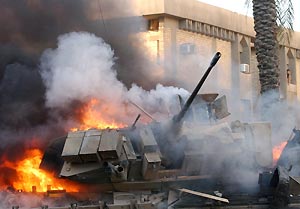
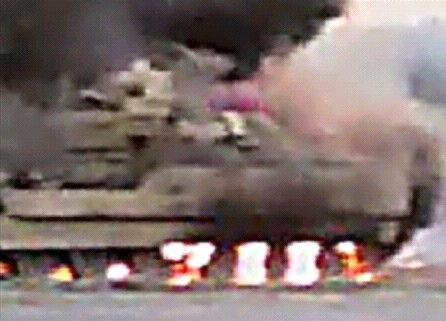
In the honest places of aviation, like fighter aircraft and civilian aerobatics, pilots and all aircrew have the humility to admit their aircraft could be disabled and have ejection seats or bail-out parachutes. In ground combat, even the narcissistic light infantry has medics, doctors and ambulances to try to save their lives when they fail to be bullet-proof. So why do we in the mobile, armored warfare community refuse to admit the fact that some of our vehicles WILL BE HIT AND SET ON FIRE?
You can say that every ounce of our energy can/should be spent towards preventing our tracked armored fighting vehicles (TAFVs = tanks) from being hit and penetrated. We concur totally---except that when ALL of these efforts have been exhausted---we do not squander away 28% of possible armor protection using wheeled trucks like Stryker/Humvees, we employ the latest multiple armor layers and hit avoidance stealth--hybrid-electric drives, band tracks, infared camouflage etc. the fact remains some vehicles will still have their armor penetrated and be set on fire. Now we can deny this reality that a wounded TAFV needs "first aid" to prevent its loss and the men inside's death/maiming and we will suffer tactical and operational failures.
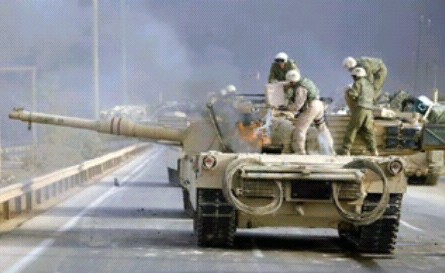
During the 3rd ID's first "thunder run" into Baghdad a lucky RPG hit into the rear grill area of a M1 Abrams heavy tank resulted in the entire column being stopped trying to put the fire out with hand fire extinguishers and absurd use of precious drinking water; exposing the entire force to enemy fires that could now concentrate on a static target of TAFVs in a long row. Later on, this abandoned heavy tank became center of a cat & mouse struggle between us and the enemy to prevent it from being captured and sold to the Russians for technology secrets. This individual vehicle debacle process is not isolated to major nation-state wars: during the current rebellion in Iraq, a Bradley medium TAFV was set on fire by a car bomb and because we couldn't put the fire out and did not want it to fall into enemy hands, we lost both the vehicle and had to kill Iraqi civilians, adding fuel to the rebellion's moral level of war fire.
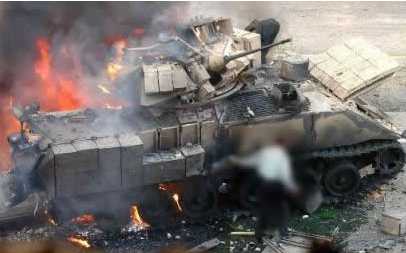
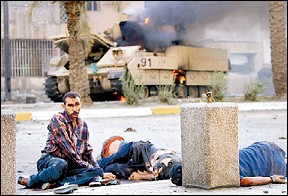
http://images.usatoday.com/news/_photos/2004/09/12/baghdad-inside.jpg
The day of violence began at dawn when a volley of 12 mortar shells was fired into the Green Zone. As the shelling continued, U.S. troops backed by armored vehicles moved into the streets searching for the attackers.
A Bradley Fighting Vehicle rushed down Haifa Street near the Green Zone to assist a U.S. patrol when it was disabled by a car bomb, the U.S. military said. Two crewmen were wounded by the bomb and four were injured by grenades and small-arms fire as they fled the Bradley, the military said.
Jubilant fighters, curiosity seekers and young boys swarmed around the burning vehicle. Several placed a black and yellow banner of Tawhid and Jihad in the barrel of the Bradley's main gun.
U.S. Soldiers called for air support. As Army helicopters flew over the burning Bradley, "they received small-arms fire," a military statement said. The helicopters "fired upon the anti-Iraqi forces and the Bradley preventing the loss of sensitive equipment and weapons," the statement said. "An unknown number of insurgents and Iraq civilians were wounded or killed in the incident." Iraq's Health Ministry said 13 people were killed and 61 injured, though it was unclear how many were killed by the helicopter strike.
More details on the Bradley fire incident above: Best Video Yet of Iraq Occupation Debacle
 www.brasschecktv.com/page/24.html
www.brasschecktv.com/page/24.html
http://video.google.com/videoplay?docid=-3519855663545752103&q=Iraq%3A+The+Hidden+War&hl=en
Strategic
Its clear that U.S. is content to watch Iraqis kill each other with a puppet government in name-only control as oil resources are taken and contractors get rich building static garrison bases for American military SASO racket. Iraqis resent Americans living in former dictator palaces. You have to ask the question how many bombings would be taking place if there was no American green zone? There's also no doubt that Iraq is in civil war now.
Operational
They know WALLS work to keep green zone insulated from the rest of Iraq but lack vigor to apply separation wall to keep Sunnis from Shias to pacify the country or to build fencing to keep Iran/Syria out. Refusal to picket roads to prevent them from being seeded with land mines results in no operational maneuver and defacto control of Iraq by all the armed groups.
Technotactical
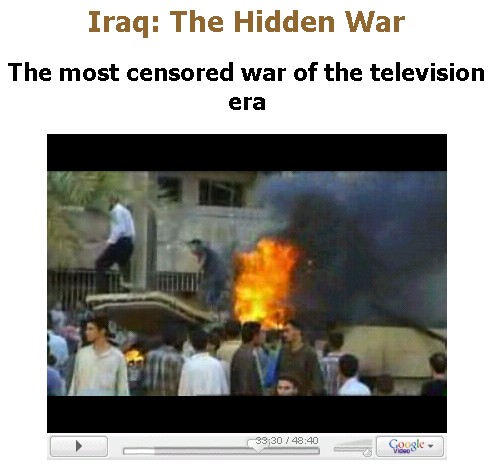
Around 33 minutes into documentary a Bradley is on fire and Iraqis are on top looting/cheering when an OH-58D Kiowa Warrior fires on them with rockets, killing several.
First, it highlights the Bradley's poor design of fuel tank in center which can and should be fixed by left/right rear fuel tanks like M113A3 Gavins have. A fire there may not even force crew to abandon vehicle in first place, preventing looting orgy.
Next, we should have with every convoy/patrol/formation/clusterfuck of vehicles a FIREFIGHTING Gavin to put out a vehicle fire and buddy tow stricken vehicles to prevent looting orgies in first place and not to kill civilians and ratchet level of violence up. We are not squared away here.
Here's a recent tragedy from the vulnerable Humvee SASO truck debacle that still takes place daily in Iraq.
Soldiers burning to death in BS Humvees in Iraq and SFTT calls people "REMFs"
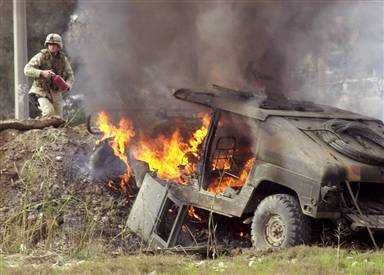
U.S. Army Soldier burns to death in allegedly "armored" Humvee truck in Iraq
"Platoni spent four months in Ar Ramadi, near Baghdad, where her battalion was under constant attack by insurgents. 'They were watching their fellow Soldiers burning to death and thinking they might be next,' says Platoni.
--U.S. News & World Report, October 9, 2006; "Treating War's Toll On The Mind: Thousands of Soldiers have post-traumatic stress disorder. Will they get the help they need?" By Betsy Streisand
Here in typical look-at-everything-through-the-glasses-of-penis-size and "respect", comes a horrific tale of equipment unpreparedness for vehicle fires. Ex-marine Charles as a typical FIDO narcissist/egotist tells the FOBBITs to change their MOS and become infantry victims as if that's the answer to everything, when the problem is VICTIM INFANTRY IN WHEELED TRUCKS WHEN THEY SHOULD BE IN TRACKS THAT HAVE ORGANIC FIREFIGHTING VEHICLES (GIDO). Iraq is a debacle directly because of the Rumsfeld "lighter and unarmored" RMA and U.S. military "presence patrol" garrison narcissism. Its an irresponsible thing to ego elevate ANY necessary part of an organization above the other; if for example everyone could became a big-penis "trigger puller" where would the fuel come from? Who would do the medical life saving? Where would the food come from? A typical immature and unhelpful USMC egocentric attitude. The ideal is EVERYBODY FIGHTS AND EVERYBODY WORKS. The "works" refers to all of the necessary tasks that are NOT about sexy, manhood showcasing kill/capture an Army organization needs to do to defeat the forces of the earth as well as against other humans. In the adult civilian world, for car accidents we have "jaws of life" to extricate people in crushed car bodies....why 4 years into a non-linear war, the U.S. military doesn't have any kind of equivalent? Probably because every problem is looked at like some kind of ego gut check instead of being looked at from the objective view of CAUSE & EFFECT. I emailed Roger Charles of SFTT below:
Subj: Iraq vehicle MEDEVAC BS
Date: 6/25/2006 2:42:54 AM Eastern Daylight Time
From: DynmicPara
To: Sfttpres
1. Even a vanilla M113 Gavin at 1.5 inch thick armor rolling on steel tracks with rubber pads is better protected than ANY "armored" Humvee which also rolls on air-filled rubber tires
The American headquarters doesn't no shit about armored vehicle design and/or is perpetuating the Humvee truck BS that suits their light infantry narcissism
THE POINT HERE IS NO ONE SHOULD BE OUTSIDE THE FOB DOING COMBAT IN ANYTHING LESS THAN A LIGHT M113 GAVIN ARMORED TRACK.
2. The up-armored M113A3 "Super Gavin" is THE BEST protected vehicle in Iraq today. While not V-hull shaped like the wheeled Cougar, its still has tracks/roadwheels to absorb blast effects coming from sides. No one has died IN a Super Gavin in Iraq so far.
www.combatreform.org/m113combat.htm
Super Gavins should be the mobility and protection standard in Iraq.
FYI the Bradley does NOT protect as well as its 33-ton weight suggests; ITS FUEL TANK IS IN THE CENTER. THE ARMY REFUSES TO PLACE FUEL OUTSIDE THE HULL ON LEFT RIGHT REAR AS M113A3 GAVINS and Stryker trucks do. This means ANY blast effect penetration into the fuel tank incinerates everyone inside. LTC Burton of the USAF demonstrated this:
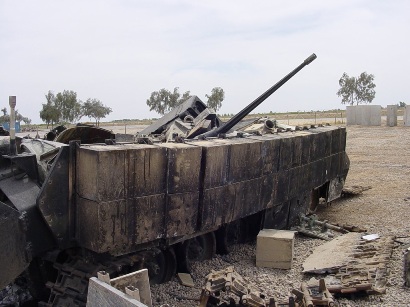
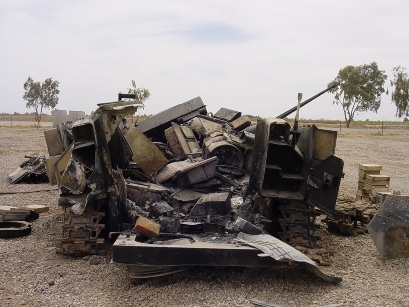
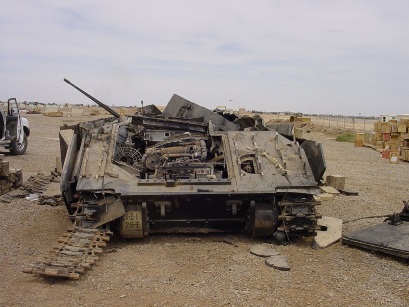
 www.youtube.com/watch?feature=email&v=bZtpO53bYm0
www.youtube.com/watch?feature=email&v=bZtpO53bYm0
Bradley after center fuel tank-fed fire melted it down to a pile of metal; Army refuses to get center fuel tankage out of their Bradleys
3. Vehicle Firefighting
www.reocities.com/armorhistory/tafvfirefighting.htm
THE REALITY IS IN COMBAT VEHICLES WILL CATCH ON FIRE.
What we need is TACTICAL FIREFIGHTING VEHICLES THAT ARE ALONG WITH EVERY CONVOY TO INSTANTLY PUT OUT VEHICLE FIRES WITH FOAM.
Otherwise excuses like "C'est la guerre" are not going to stop Soldiers from burning-to-death needlessly.
Airborne!
Mike Sparks
www.sftt.us/cgi-bin/csNews/csNews.cgi?database=HOME%20DefenseWatch%20FTE%202.d b&command=viewone&op=t&id=1&rnd=303.7956526911848
06-23-2006From the Editor:
Abandoned On The Killing Fields - No Medevac Coming
By Roger Charles
A recent IED attack has surfaced an ugly truth -- the Grunts doing the great majority of fighting and dying in Iraq are considered "more expendable" than their REMF comrades, and the people making this determination are themselves, you guessed it, REMF's!!
(Now, before I get a couple hundred emails protesting my use of "REMF's as disparaging of some of our military who are themselves at risk, let me make this point. There is "risk" back in an FOB, no question. Is it the same risk as those who work outside the FOB? Don't think so. Is risk outside the FOB spread evenly? No -- go to one of the infantry companies in Ramadi, or Fallujah, and then compare that risk with someone running convoys between Ramadi and Baghdad. Not the same, but one hell of a lot more than someone back in the TOC at the FOB. And, I fully appreciate the risk faced by our Combat Engineers as they clear roads, and our EOD studs as they deal with IED's/EFP's. A special salute to our Combat Medics/Corpsmen out in the killings fields while I'm at it. And, the drivers who haul ass through IED Avenue -- you've damn sure got my respect!! But, bottom line -- if I've offended anyone who has dodged the occasional mortar shell in route to Burger King, or who has to make do with a 36-inch plasma tv while others, in the Green Zone in Baghdad have 42-inch sets, then I don't apologize. If you want me to place you in the same category as The Grunts, change MOS's! Until then, have the intellectual honesty to admit that REMF's are not deserving of the same respect given to Hack's "Warriors," even if you get the same "Imminent Danger Pay." Let me make it clear that while I respect all who serve our great nation, I am not blind to the reality that not all who serve, share the same threat of death, or of crippling or maiming wounds. And, as to who is a REMF, and who is not -- it's between you and your conscience. If the "shoe" fits, wear it.)
So, imagine this scenario -- you and your buddies have finished another day of training Iraqi troops and are headed back to your FOB (Forward Operating Base) when an especially nasty IED (in the form of EFP, an "Explosively Formed Projectile") explodes into the lead Humvee in your column of three.
The blast is strong enough to flip the Humvee into the air, landing in a ditch on it's top.
Here's what happened, in the words of America's Grunts who where there.
-----------------------------------------------------------
To: Soldiers For the Truth
From: The NCOs of the 4th INP Brigade SPTT Team
The 4/1 SPPT Team was traveling back from Salman Pak to Camp Rustamiyah along EFP alley (RTE Pluto South) on Sunday May 14th about 5:15pm in a 3 vehicle convoy. About 3 miles from Camp Rustamiyah, the first Humvee was hit by a massive roadside bomb called an EFP. The bomb blew the HUMVEE into the air and created a giant cloud of debris, dirt and pavement. We stopped as fast as we could and when the smoke cleared enough, we could see the first HUMVEE had been completely blown off the road and was lying upside down in a ditch. To make matters worse it was also on fire. The rest of the team tried to free the driver and vehicle commander from the wreckage but the frame of the HUMVEE was bent and the door would not open. The two Soldiers in the front were trapped inside the burning vehicle and died. We could only pray that they were already dead from the EFP blast and did not burn to death. We tried to pull the front doors off with a winch and a tow strap, but the burning ammunition inside the wreck started to explode and the entire vehicle caught fire and blew up. The gunner was pulled from the wreckage and was severely wounded with shrapnel wounds from the spalling. The Medic with the SPTT Team was able to start working on the gunner to save his life and we gave the interpreter aid as best as we could. A MEDIVAC was immediately called for the litter urgent and critical Soldier and the QRF rolled from the FOB. About 10 minutes later the tanks and HUMVEES of the QRF got there and secured the area. What happened at this point is what we need your help with.
The MEDIVAC was denied because we could not guarantee the LZ was not hot. Even with the QRF securing the area, the MEDIVAC was not launched. We were told we had to transport the severely wounded Soldier and interpreter back to the FOB, have the aid station stabilize them and the MEDIVAC would then fly to the FOB to pick them up. To complicate matters the QRF did not have an ambulance with them, because the medical until will not roll any of the 20 odd HUMVEE and M113 combat ambulances with the QRF because it is too dangerous outside the FOB. We had to put the Soldier in a HUMVEE and drive him to the FOB, where the chicken shit medics were waiting inside the FOB gate to transport him, via ambulance to the TMC. Thank God this Soldier is still alive and on his way to Landstuhl. The two Soldiers were eventually pulled from the wreckage after a HEMMIT with a tank pump unit put out the fire that engulfed the wrecked HUMVEE. It took the HEMMIT almost an hour to get to the site, 3 miles away from the FOB, because the KBR contracted Fire Department and EMT unit refused to leave the FOB, because their contract states they will ONLY work within the protection of the FOB.
Their brand new fire engines and rescue vehicles were waiting inside the gate when we finally towed the wrecked HUMVEE back. By the time the HEMMIT arrived, both Soldiers were burned beyond recognition, to the point where their own wives could not recognize them. Last night at 1:00am in the morning, we loaded the body bags on a helicopter to BIOP and to start their trip home
When we asked why the MEDIVAC would not land on a secured LZ to MEDIVAC the critically wounded Soldier, we were told "the policy is that we cannot afford to lose a Blackhawk and crew flying into potentially hostile LZ." We work in Salman Pak, which is almost an hour southeast of Baghdad. If a Soldier is wounded, we are expected to self-evac him back to Rustamiyah because "it is too dangerous to send a MEDIVAC, Ambulance or M113 combat medic vehicle (even if it is with the QRF). From (t)he time we landed in Kuwait and after we arrived in Iraq, we were given MEDIVAC procedure cards and even given a MEDIVAC Freq. We were told that all we had to do is call and follow the procedures on the card and a MEDIVAC would be launched. This is BOGUS! ALL Soldiers need to know that unless they are at a FOB, the MEDIVAC will not be launched. Fire departments, EMT, combat medic vehicles, field ambulances all have orders not to leave the FOB because it is to(o): "dangerous." The reality is if you are wounded, you are SOL until your own unit puts you into a HUMVEE and you get back to the FOB.
Please help us contact [deleted] about this policy. 4th ID is telling us that "this is just the way things are." That, "these things happen." We need your help before this is swept under the rug.
-----------------------------------------------------------
Editor's note: when asked for more details, how the death-dealing device was situated, etc., here's the reply from a long-time SFTT supporter.
"It was an EFP, half buried and emplaced near a grove of trees. We could not see it...
I was in the vehicle directly behind the EFP strike and we barley managed to evade a secondary EFP. The EFP was a 7-8 array 155mm Iranian made weapon. It was set by the Mahdi Militia, the same Mahdi Militia that the murderous thug al Sadr is the leader of and the Iraq Shia dominated government allows to operate or tacitly approves.
The NCO's put this letter together because nobody is listening to them. Even the division SGM Major is giving them the cold shoulder. Read this and if you have any questions, I can answer and corroborate anything in the letter.
-----------------------------------------------------------
Editor's note: In another email, this stand-up Army officer had this to say in response to my query about the current system of MEDEVAC priorities.
Roger,
There are 3 levels, litter, litter urgent and critical. The problem is that the Soldiers are given MEDIVAC Cards with freq and procedures, and briefed that if you need a MEDIVAC for a wounded Soldier, you call one and it will be sent. The priority is given to critical care, but the Soldiers are told a MEDIVAC will be sent. The reality is, unless you are at a FOB, a MEDIVAC will not be sent. The MEDIVAC will only land at the FOBs. There are a plenty of M113s that have red crosses and are configured as ground MEDIVAC, but they are not used because they ar deemed "unsafe." Fact is the uparmored HUMVEE has as much or less protection, so that argument losses merit. Yes, there are plenty of Bradleys in 1-33 CAV at Rustamiyah, but they sit most of the time. 3-67 Armor only runs M1s. There is no Ground MEDIVAC with the QRF.
I talked to the NCOs and they say print it. I have requested a 15-6 as to the MEDIVAC, so the NCOs say address the letter as written By The NCOs.
-----------------------------------------------------------
Editor's note: When I queried our source about whether this policy was theater-wide, or a local commander's decision, here's his response.
Roger,
This is the answer regarding MEDIVAC Ops.
MND-B policy states unless there is Zero risk of hostile fire, the MEDIVAC will only land at he nearest FOB. The unit will self evacuate he wounded to he nearest FOB, where the MEDEVAC will pick them up and transport the wounded to the CASH.
MND-B policy also states that no M703 Humvee Ambulance or M113 Combat Ambulance will leave a FOB. These vehicles are considered to be unsafe against IED and EFP attacks. (Emphasis added.)
------------------------------------------------------------------------------
Editor's note: Now there's a mind-blowing admission -- the "Dust-off" chopper and crew cannot be exposed to any risk of hostile fire!! Last time I looked, this was a "hostile fire pay" (aka Imminent Danger Pay) zone... Ummm?? And, please note, this is not a policy set by the crew, or the supporting aviation unit. I have zero doubt that U.S. Army aviators would fly these missions, if permitted. My source then included the following statement from the HQ element justifying the "no fly MEDEVAC, if bullets fly" policy.
From: MCD-B, 4ID HQ, G3 CHOPS
Subject: MEDEVAC
ALL:
I suspect many of your staff, like ours at Division, are in the middle of answering questions regarding MEDEVACs. Please review the MEDEVAC information below with your teams, whether new or seasoned at this point, in order to make sure we are all working from the same understanding of our MEDEVAC call procedures.
The basic scheme is to call MEDEVAC on the established MEDEVAC frequency so the information concerning casualties is passed directly to the people that can help, namely the MEDEVAC CP, hospital emergency room, and Division CP. All soldiers carry a MEDEVAC 9 Line Request card and can call for a MEDEVAC if necessary.
Once the request for MEDEVAC is requested on the MEDEVAC net is that the aircrews can immediately begin preparing for the mission. Once the 9-line is received and verified, the following actions must take place, some simultaneously:
Flight medic verifies nature of the injury and gathers as much information from the unit on the ground as possible so he/she can get a backboard or other extra equipment, like starting the oxygen generator on some of the helicopters.
One pilot goes with a crew chief to the helicopter and begins start-up procedures, which for a UH-60 takes nearly 15 minutes.
The other pilot begins the mission approval process, which requires him to brief his mission and receive risk approval from the appropriate authority, which in the case of MEDEVAC is the Aviation BN S3, XO or Commander.
If the first and primary means for a MEDEVAC call is on Ventrillo, then we add at least 5 minutes to the response time and inject the likelihood of information being transmitted or written down incorrectly as it works its way up from the point of injury, through the various levels of command to Division, then back down to the MEDEVAC unit.
Again, please pass this to your staff can ensure a common understanding of MEDEVAC procedures and continue to do the very best for our injured Soldiers. (Emphasis added.)
vr
IRONHORSE!
MND-B G3 CHOPS
LTC D--- H--- (1500-0300)
MAJ G--- D---- (0300-1500)Editor's note: Imagine that you were in the convoy, had just endured the death of two comrades & the wounding of one more (and the Iraqi interpreter), only to find out that you had been abandoned on the killing fields! For however the PAO monkeys try to spin this, the reality is that this group of Soldiers were, at the moment of maximum emotional trauma, told that you are there alone. We will not send MEDEVAC, air or ground, to assist. And, later, when "the policy" is questioned, some field grade REMF will have the audacity to claim that the command will "continue to do the very best for our injured Soldiers." I don't know what Hack would have to say in response to this sad and pathetic situation, but if he was on-scene, he'd have gone to aid these Soldiers if he had to ride a bicycle, or walk.
Some of you are no doubt wondering why it took so long to get this information posted, since the event took place on May 14. Good question, and I owe an apology to the NCO's who had the cajones to stand up and say, "this is not right, and we will not quietly accept being abandoned on the battlefield." When this information first came to SFTT, I took it to a national media outlet who promised to give it the attention it deserved, and to do so quickly. Well, live and learn -- burned again. Won't be going back there soon. Poor judgement on my part, but that's only part of the reason for the delay. I let some other matters have more attention than they deserved, and I am deeply embarrassed for having let these great troops down. I pray for your safe return, and can only hope to be more effective the next time. I hope you guys forgive me.
s/f,
Rog Charles
SFTT President Roger Charles is an Annapolis graduate, a retired USMC Lt. Col. who commanded an infantry platoon in I Corps during the Vietnam War, is the winner of the prestigious Peabody Award for news coverage, and was a protégée's of the late Col. David H. Hackworth. Rog can be contacted at sfttpres@aol.com. Please send comments to DWFeedback@yahoo.com.
SOLUTIONS: GET ARMORED FIREFIGHTING VEHICLES, NOW
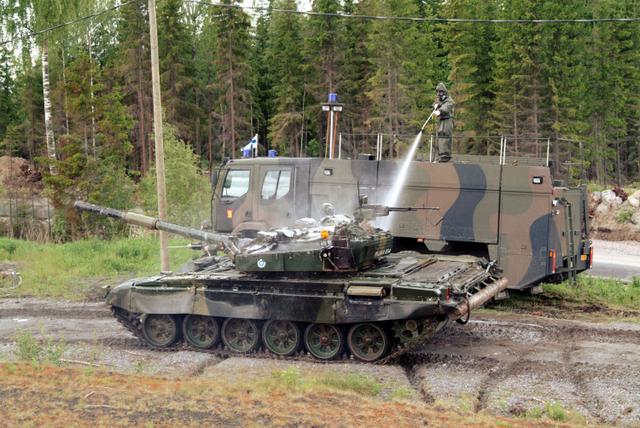
Its high time we have a "Plan B" for times when even our best armor fails. PROFESSIONALS realize this; the U.S. military however is a BUREAUCRACY of weak ego lemmings. However, the truth is apparent to those that read Belton Cooper's book, Death Traps that while armored vehicles can be knocked out most if not all, of them can be recovered and put back into service, if they are not allowed to totally incinerate. If we could whenever we go into battle, have "first aid for tanks" instantly available in the form of specialty firefighting M113 Gavin TAFVs and/or trailers we could not only save the tanks for repair & recovery we could save many lives who would have been lost because we backed off and let a fire spread and burn inside a friendly TAFV. When you consider a M1 Abrams heavy tank carries 500 gallons of fuel, its absurd that all we have to put out a fire after onboard HALON is dumped is hand fire extinguishers. Often, a vehicle's armor is penetrated and no one is killed or hurt, but the tank is lost because we cannot put the fire out satisfactorily to connect it to a tow bar and take it with us or back to repairs.
MEET THE M113 FIREGAVIN!
 www.youtube.com/watch?v=EqjRwZSmdM0
www.youtube.com/watch?v=EqjRwZSmdM0
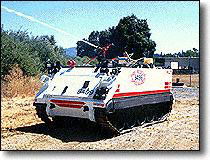
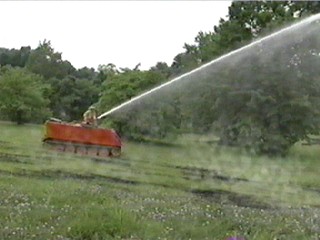
UDLP Special Application - FFV
M113 Carrier Defense Conversion: Fire Fighting Vehicle Options
As M113 Gavin carriers become excess in the military system a number of conversion options are being considered for asset utilization.
As an example of its utility, United Defense, L.P. has developed fire fighting options, like the model shown on the right.
At a minimum, the carriers would provide the following capabilities: 250 gpm compressed air foam systems providing 800 plus gallon water tank, vehicle protection spray, and remotely actuated turret, air-conditioned/insulated/filtered cab, 20,000 lb. winch, remote back fire lighting system, light dozer blade, and drivers thermal or light intensifier sight aids.
www.uniteddefense.com/www.m113.com/ffvcharac.html
FFV Characteristics
M113 Carrier Defense Conversion Fire Fighting Vehicle Characteristics*
General
Weight, fully loaded 40,000 lb. (18,144 kg)
Empty weight 26,000 lb. (11,793 kg)
Ground pressure, fully loaded 8.63 psi (0.60 kg/cm2)
Personnel capacity 4
Fuel tank capacity 120 gallons (454 liters)
Performance
Speed on land 41 mi/h (66 km/h)
Water fording 40 in. (101 cm)
Cruising range 300 mi (483 km)
Turning radius Pivot to infinite
Slope 60%
Side slope 40%
Trench crossing 88 in. (223 cm)
Vertical wall climbing 30 in. (76 cm)
Braking (20-0 mi/h) 40 ft. (12.2 m)
Firefighting Equipment
Compressed Air Foam System 250 gpm, 200 ft range
Turret 180 frontal fan
Water tank Diesel
Refill options 1,500 gallons
Dozer blade 2-way, 102" wide
Winch 12,000/24,000 lb.
Transfer pump (optional) 2,000 gpm draft
Powertrain
Rated Horsepower 400 hp
Fuel Diesel
Transmission type Hydrokinetic
Steering type Hydrostatic
Brake type Multiple wet plate
Running Gear
Suspension Torsion bar
Road wheels 6 pr per side, 24 inch diameter (61 cm)
Track type Steel single pin, detachable rubber pad
Track width 15 in. (38 cm)
Wheel travel 15.8 in. (40.2 cm)
Electrical System
Generator
Amperes 200, 300 optional
Volts, dc 28
Batteries 4, low maintenance, 120 amp-hr, 12 volt-each
What I first propose is an in-house, armor branch focused solution that every armor battalion have a company of 12 x M113 Gavin light TAFV firefighting vehicles with 12 firefighting trailers. The drivers and track commanders of the Armored Firefighting Company (AFFC) would be the experts in vehicle firefighting and crew rescue interfacing with M88 maintenance contact teams to evacuate the wounded tanks and with the medical platoon to MEDEVAC any wounded Soldiers. Their M113 Gavin light TAFVs would have a large fire suppressant foam tank in their troop compartment and in the top a mini-turret with a hose to spray the foam directly into a burning tank or other vehicle to rapidly smother any fires. Co-axial to the water foam sprayer unit would be a ASP gas-operated or M230 electrically-operated 30mm autocannon for self-defense fires. A simplified single-ammo feed 25mm Bushmaster cannon is also a possibility. Their firefighting trailers would have an unique "smother" capability to either the left or right. The firefighting trailer is pulled up abreast of the burning vehicle and a sudden spray of fire retardant foam/chemicals is on electrical command released to either the right or left to smother the vehicle fire. The idea here is that the firefighting trailers could be dispersed throughout the armor battalion and the task forces assembled with infantry, combat engineers etc. to provide more firefighting means than just the dozen Armored Firefighting Company's dozen Gavins for a total of 24.
Each firefighting Gavin would also have an engine powered water pump and a short section of hoses to connect to an urban water main to get more water to make more foam or to use pure water for building fires. The 1993 disastrous raid on the Branch Davidians in Waco, Texas demonstrates that we need firefighting to follow directly on the tail of urban assaults to minimize civilian casualties. The Philadelphia police department raided the urban terrorist group MOVE with a satchel charge onto an armored roof that started a fire that burned down a city block. In the 1989 invasion of Panama, unchecked fires destroyed dozens of buildings in Panama City. The point here is that people cause wars and they live in cities---as they become congested in uncontrolled and dangerously conceived shanty towns the risk of fire destroying the city we are trying to save must be avoided with pro-active actions by us so small fires are put out before they become big fires. The Armored Fire Company would be one of many modern-day Percy "Hobart's Funnies" we would use to prevail in urban combat---a trailer with extra hoses would be towed so they could follow infantry building clearing teams putting out fires or being used as non-lethal means to keep civilians away from the fight. The disastrous practice of letting civilians burn cars and tires that makes it look like we have no control of the situation--must be stopped by our organic Armored Firefighting Companies.
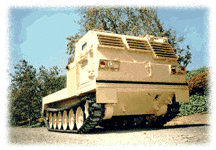
Another option to consider would cost a bit more money but dramatically offers more capabilities using the XM1108 Gavin as the baseline vehicle for an Armored Multi-Purpose Combat Company (AMPCC) in the new RSTA squadrons of every Army modular brigade. If we are going to lose 1/3 of our combat maneuver power we had at least gain some new capabilities. The XM1108 has a flat bed area in the back for palletized loading system (PLS) flat racks to be attached and detached, as well as 20-foot ISO containers. The AMPCC would be where most of our modern-day Hobart's Funnies would be located--with firefighting modules as well as ladder modules, hydraulic boom capsules to lift an infantry fireteam to a roof or upper story window or mousehole created by a surprise demolition charge. Ideally, the Army's M58 smokescreen generating Gavins and M56 smokescreen generating Humvee trucks in Chemical companies should be integrated with the AMPCC by some sort of merger to render screening smoke during firefighting and urban assault operations. The beauty of the XM1108 Gavin is that they can be used to drop off firefighting modules to the ground by a fire or onto another PLS capable vehicle as they pick up a ladder or boom capsule module. The M58 Gavin smokescreen light TAFVs should have 2.75" Hydra 70mm rocket launchers to project smoke as well as high explosive rockets to help subdue enemies in buildings. The AMPCC can also pick up PLS flat rack modules that shoot 2.75 inch, 227mm HIMARS rockets, a 155mm tube howitzer or even a 165mm demolition gun, or series of 106mm recoilless rifles in an armored cab for AMPCC Soldiers---who should all be combat engineers except for the 227mm HIMARS rockets that would be handled by Red Leg artillerymen. The XM1108 Gavin can be a 21st century ground equivalent of the Vietnam Huey helicopter that was so versatile as an air platform that at one time every Army branch had a version of it--artillery had them packed full of rockets, "slicks" carried infantry etc. My suggestion is to place this "modular" vehicle in the "modular" brigade RSTA squadron using some of the manpower of the converted 3rd maneuver battalion to get decisive combat capabilities we do not have now. As another example, XM1108 Gavins could carry the fuel, gun/2.75 inch rocket pod armaments and repair parts on PLS flat racks and have dozer blades to scrape out a short "grasshopper" landing strip for a section of AY-65 Thrush Vigilante 2-seat observation/attack aircraft towed on trailers that would reside in the RSTA squadron to insure no matter what that fixed-wing maneuver air support capabilities would always be organic to Army maneuver brigades. The AY-65 Vigilante is an easy-to-maintain, 2-seat armored, 200 mph fixed-wing crop duster that can lay smokescreens as well as observe, report and attack ahead of our maneuver elements using an enlisted observer with stabilized binoculars, day/night sensors and rocket/gun pods.
Of course these firefighting tracks can decontaminate other vehicles in event of nuclear, biological, chemical (NBC) attacks...
One last lethal thought, the firefighting spraying capabilities could also be turned around and made into firemaking capabilities with a little forethought in the initial design. Flame-thrower tanks were very effective in the jungles of WW2 Pacific islands and in Vietnam to burn away vegetation the enemy used to hide in. They also can be devastating psychologically to an enemy in urban combat.
NOTES
When your troops are coming home with PTSD its because the U.S. DoD/military brass have set them up for failure driving around in Humvee/other wheeled trucks on the HE-dominated non-linear battlefield (NLB).
www.reocities.com/transformationunderfire/highexplosives.htm
With a better CONOPS using better armored tracks, we'd need less than 50, 000 troops in Iraq and have more in Afghanistan actually getting OBL & company. Soldiers that are winners in a winning CONOP that don't have to shoot into civilians don't get PTSD when they win easily. Stability ops should be done by a dedicated Stability Corps:
www.combatreform.org/johnpaulvann.htm
If we are going to use motor-driven vehicles, we need to have firefighting vehicles in every movement formation.
This Web Pages:
www.reocities.com/armorhistory/tafvfirefighting.htm
Harrier Burns: Where are the FireGavin UGVs?
 www.youtube.com/v/7aydbBl6_W0
www.youtube.com/v/7aydbBl6_W0
Recently a $35M (1997 dollars) RAF Harrier STOVL fighter-bomber had a hard landing at Kandahar Air Base and caught fire from its unsafe fuselage fuel tanks co-located with its vectored thrust nozzles. The pilot had to zero altitude eject and parachute away from the flaming wreckage. However, what's disgusting is that the wheeled fire trucks took so long to arrive that the aircraft was a total loss by the time they arrived when had the fire been promptly put out most if not all of the $40M plane could have been salvaged. Had it been a flimsy tube & wing civilian airliner--like Air India Flight 812, several weeks ago--the passengers would burn-to-death before the fire trucks arrive.
www.ndtv.com/news/india/air-india-crash-no-distress-signal-from-pilot-before-crash-say-sources-27092.php
Enough is enough.
Human beings don't want to sit in fire trucks positioned at the edges of runways as they should; we ain't the WW2 "Greatest Generation". FINE. We are lazy. However, that's still no reason to let planes and people burn up. There's no reason why we couldn't modify plentiful M113 Gavin light, tracked tanks into foam fire fighting "FireGavin" Unmanned Ground Vehicles (UGVs) that can already be in position at the runway's edge ready to respond INSTANTLY to a crash and spray life-saving foam by REMOTE CONTROL. Fire-fighting UGVs MUST BE TRACKED in order to GET TO THE CRASH SITE which often is NOT on the airport because the damaged plane couldn't get there and crashes and burns nearby where there are no roads.
We must have a CROSS-COUNTRY MOBILE fire fighting UGV capability that is already pre-positioned to not waste even one second getting the life-saving foam to smother the fire.
www.combatreform.org/WHEELSVSTRACKS/index.htm
FireGavin UGV operators can be miles away in an air-conditioned surveillance station for the hours, days, weeks, months and years before a crash occurs in shifts. The FireGavins themselves could also be operated by human drivers/water nozzle operators as an option like for ground combat operations to put vehicle fires out and save lives:
www.combatreform.org/ARMORHISTORY/tafvfirefighting.htm
For the cost one one $40M Harrier burning up we could have created over 40--if not more--M113 FireGavin Unmanned/Manned GVs to completely ring an air base with instant firefighting means. These same vehicles can be used for ground combat maneuver operations and putting out Forward Operating Base (FOB) fires if attacked by the enemy. In riot control situations, the water hoses can be used to disperse angry crowds without harming them--which is vital if we are going to address their grievances and not make them into rebels.
www.combatreform.org/johnpaulvann.htm
TRUE HORROR STORIES--WE CAN AVOID WITH FIREFIGHTING GAVINS
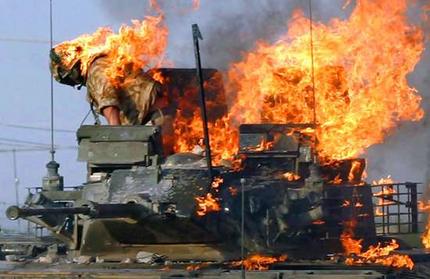
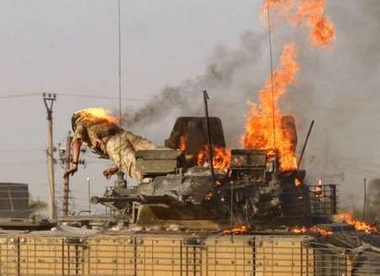
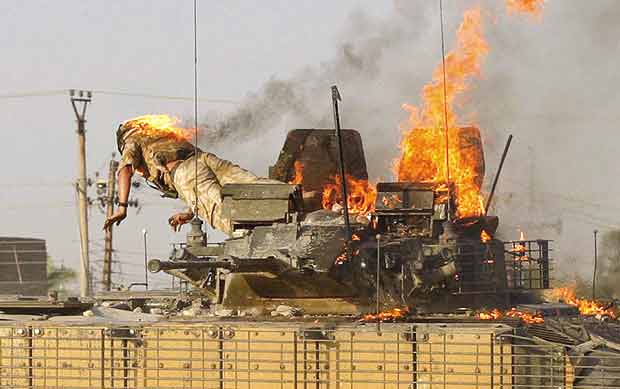
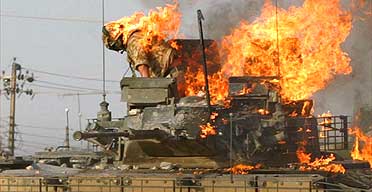
British Warrior like our Bradleys need fold-down/up SHIELDS on top to prevent Molotov cocktails from being thrown at them!
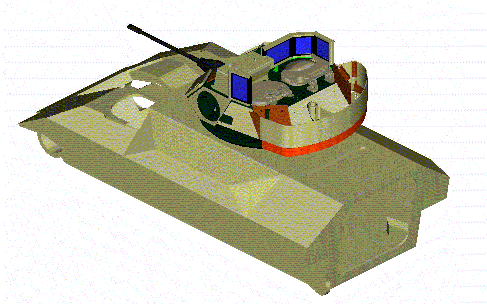
U.S. News & World Report
October 9, 2006
Treating War's Toll On The Mind
Thousands of Soldiers have post-traumatic stress disorder. Will they get the help they need?
By Betsy Streisand
As they take their seats in the movie theater, Eric and Raquel Schrumpf could be any young couple out on a summer night in Southern California. No one notices as Schrumpf, 31, a former marine sergeant who served in Iraq, scans the rows for moviegoers who may be wired with explosives under their jackets. No one pays attention as a man who appears to be Middle Eastern, wearing a long coat with bulging pockets, takes a seat in the same row as the Schrumpfs and Eric starts watching him intently. No one listens as Schrumpf instructs his wife to "get as low to the ground as you can if something happens." Then something does. Schrumpf hears metal jangling as the man reaches into his pocket. Convinced he is a suicide bomber about to strike, Schrumpf lunges at him. The man jerks away and his deadly weapon falls to the floor: a can of Coke.
Schrumpf has everyone's attention now, as he and his wife quickly leave the theater. The Schrumpfs can't even remember what movie they went to see. Not that it would have mattered. Eric Schrumpf had room for only one movie in his head, the one where he is in Iraq. Now, more than two years later, Schrumpf has a good job, a strong marriage, a couple of pets, and a life that looks startlingly like everyone else's in Orange County, Calif. But he is still never more than a sound, smell, or thought away from the war. He gets anxious in a crowd, has been known to dive for cover, even indoors, at the sound of a helicopter, reaches for nonexistent weapons to be used in nonexistent circumstances, and wakes up screaming from nightmares about burning bodies and rocket-propelled grenades. "I'll never be the same again," says Schrumpf, who as a weapons and tactics instructor with the 5th marine regiment was part of the initial push into southern Iraq in 2003. "The war will be part of my life and my family's life forever."
Reliving the war. Like thousands of Soldiers who have returned from Iraq and Afghanistan, Schrumpf is suffering from post-traumatic stress disorder [PTSD], a chronic condition whose symptoms include rage, depression, flashbacks, emotional numbness, and hypervigilance. It can be brought on by a single event, such as when a grenade landed next to Schrumpf, ticking off his death and then failing to explode. Or it can be the result of repeated exposure to trauma such as house-to-house firefights or the accidental killing of civilians. "Soldiers who are routinely exposed to the trauma of killing, maiming, and dying are much more likely to bring those problems home," says Army Col. Kathy Platoni, a clinical psychologist and leader of a combat stress-control unit that works with Soldiers on the battlefield. At its most basic, PTSD is the inability to flip the switch from combat Soldier to everyday citizen and to stop reliving the war at so high a frequency that it interferes with the ability to function.
The problem is as old as war itself. But this time, American Soldiers have been assured by the government and the military that the solution will be different: Iraq will be nothing like Vietnam, with its legacy of psychologically scarred veterans whose problems went unrecognized, undiagnosed, and untreated. "The hallmark of this war is going to be psychological injury," says Stephen Robinson, a Gulf War vet and director of government relations for Veterans for America in Washington, D.C. "We have learned the lessons of Vietnam, but now they have to be implemented."
[EDITOR: BULLSHIT! We have NOT learned the lessons of Vietnam to stop closed terrain infiltration!! WIN THE WAR and you don't get PTSD. The better you can win the war with military superiority, the less bloodshed = less horrors.]
Since the war began, the departments of Defense and Veterans Affairs have stepped up efforts to address the mental health needs of Soldiers before, during, and after they are deployed. And more effective treatments for PTSD have been developed. But as the war drags on, the psychological costs are mounting and so is the tab for mental health care. Troop shortages are driving already traumatized Soldiers back into combat for three and sometimes four tours of duty. Those who make it home often feel too stigmatized to ask for treatment lest they jeopardize their military careers. And if they do ask, they often can't get the care they need when they need it.
In addition, there are concerns among veterans groups that the Bush administration is trying to reduce the runaway cost of the war by holding down the number of PTSD cases diagnosed (and benefits paid), and that the promise to protect the mental health of nearly 1.5 million troops is not being kept. "Throughout this war, everything has been underestimated-the insurgency, the body armor, the cost, and the number of troops," says Paul Rieckhoff, an Iraq war vet and founder of Iraq and Afghanistan Veterans of America in New York. "Now, the psychological problems and the needs of these Soldiers are being underestimated, too."
Just how many troops will bring the war home with them is impossible to know at this point. But the numbers could be substantial. In a study published in 2004 in the New England Journal of Medicine, researchers at the Walter Reed Army Institute of Research found that nearly 17 percent of Soldiers who have returned from Iraq, or nearly 1 in 6, showed signs of major depression, generalized anxiety, or PTSD. A report in the Journal of the American Medical Association earlier this year found that 1 in 5 Soldiers met the risk for concern. And those numbers are virtually certain to grow as the war enters its fourth year. "I do think we're going to see a whole lot more PTSD as time goes on," says Platoni.
The VA, short of doctors, therapists, and staff in some areas, is straining to meet the mental health needs of the troops who have already returned from Iraq and Afghanistan. Soldiers often wait weeks or even months to see a psychiatrist or psychologist. A 2004 study by the Government Accountability Office found that six of the seven VA medical facilities it visited "may not be able to meet" increased demand for PTSD. "I don't think anybody can say with certainty whether we are prepared to meet the problem because we don't know what the scope is yet," says Matthew Friedman, a psychiatrist and executive director of the VA's National Center for PTSD in White River Junction, Vt. "What we do know is that the greater the exposure to trauma, the greater the chance that someone will have PTSD."
Danger zone. There may be no war better designed to produce combat stress and trauma. Operation Iraqi Freedom is a round-the-clock, unrelenting danger zone. There are no front lines, it's impossible to identify the enemy, and everything from a paper bag to a baby carriage is a potential bomb. Soldiers are targets 24-7, whether they are running combat missions or asleep in their bunks. "There is no moment of safety in Iraq," says Andrew Pomerantz, a psychiatrist and chief of the Mental Health and Behavioral Science Service at the VA Medical Center in White River Junction. "That's one of the things we're seeing in people when they come back-a feeling of an absolute lack of safety wherever they are."
Stories of vets who sleep with guns and knives and patrol the perimeters of their homes obsessively are as common as tales of valor. Marine Lt. Col. Michael Zacchea, 38, who trained Iraqi troops and was in about 100 firefights, knows that paranoia all too well. "Every time I get on the road," says Zacchea, who commutes from Long Island to Wall Street, "it's like I'm back in the streets of Baghdad in combat, driving and running gun battles, with people throwing grenades at me." Zacchea, a reservist, is now being treated for PTSD at a VA hospital, but had it not been for chronic dysentery, migraines, and shrapnel wounds in his shoulder, he says he probably would have been redeployed in September, emotional scars and all.
And he still may be. The military's need to maintain troop strength in the face of historic recruiting lows means many service members, including some suffering from psychological problems like Zacchea, have no choice but to return. President Bush recently authorized the marine corps to call up inactive reservists, men and women who have already fulfilled their active-duty commitment. "They're having to go deep into the bench," says Robinson, "and deploy some people who shouldn't be deployed."
Multiple tours. Robinson is referring to the increasing number of reports of service members who stock antidepressants and sleeping pills alongside their shampoo, soap, and razor blades. The Defense Department does not track the number of Soldiers on mental health medications or diagnosed with mental illnesses. But the military acknowledges that service members on medication who may be suffering from combat-induced psychological problems are being kept in combat. "We're not keeping people over there on heavy-duty drugs," says Army Surgeon General Kevin Kiley, who estimates that 4 to 5 percent of Soldiers are taking medications, mostly sleeping pills. "Four to five percent of 150,000, that's still a lot of troops. But if it's got them handling things, I'm OK with that."
Handling things is a relative term. Army Pvt. Jason Sedotal, 21, a military policeman from Pierre Part, La., had been in Iraq six weeks in 2004 when he drove a humvee over a landmine. His sergeant, seated beside him, lost two legs and an arm in the explosion. Consumed by guilt and fear, Sedotal, who suffered only minor injuries, was diagnosed with PTSD when he returned from his first tour in early 2005 and given antidepressants and sleeping pills. Several months later, while stationed at Fort Polk, La., he sought more mental health care and was prescribed a different antidepressant.
Last November, Sedotal was redeployed. "They told me I had to go back because my problem wasn't serious enough," Sedotal said in an interview from Baghdad in mid-September. Sedotal says he started "seeing things and having flashbacks." Twice a combat stress unit referred him to a hospital for mental health care. Twice he was returned to his unit, each time with more medication and the second time without his weapon. "I stopped running missions, and I was shunned by my immediate chain of command and my unit," says Sedotal, who returned to Fort Polk last week.
Cases like Sedotal's prompted Congress earlier this year to instruct the Department of Defense to create a Task Force on Mental Health to examine the state of mental health care for the military. It is expected to deliver a report to Secretary of Defense Donald Rumsfeld in May 2007 and make recommendations for everything from reducing the stigma surrounding disorders to helping families and children deal with the traumatized Soldier.
Sending military members who suffer from PTSD back into combat goes straight to one of the toughest issues of the war: how to protect Soldiers' mental health and still keep them fighting. It is well-established that repeated and prolonged exposure to combat stress is the single greatest risk factor in developing PTSD.
At the same time, there is tremendous resistance to sending home Soldiers who are suffering from psychological wounds, in all but the most severe cases. "If a Soldier has some PTSD symptoms," says Kiley, "we'll watch him and see how he does." The expectation "is that we're all in this boat together and we need to drive on to complete the mission," he says, adding that if the situation gets worse, the Soldier would most likely be given a couple days of rest to see if he recovers. Once Soldiers are evacuated, "they are much less likely to come back."
With that in mind, the DOD has designed a program to manage combat stress and identify mental health problems when they occur. It will include so-called battle-mind training for recruits, which focuses on the emotional fallout of seeing and contributing to the carnage of war and how to deal with it. Once they are in Iraq, there are psychologists and combat stress-control teams, such as Platoni's, who work side by side with troops to help them deal with their emotions and decompress immediately after battle. "Soldiers suffering from combat stress do better if they are treated early, efficiently, and as close to the battlefield as possible," says Col. Charles Hoge, chief of the Department of Psychiatry and Behavioral Sciences at Walter Reed Army Institute of Research.
Currently, there are more than 200 psychiatrists, therapists, social workers, and other mental health experts working with Soldiers "in theater." They lend an ear, encourage Soldiers to talk about their experiences with each other, and administer whatever short-term remedies they can, including stress-reduction techniques, anger-management strategies, or medications. However, their mission, first and foremost, is to be "force multipliers" who maintain troop strength. Their success is judged by their ability to keep Soldiers from going home for psychological reasons. Soldiers are often their allies in this effort, as they feel such guilt and shame over abandoning their units they'll most likely say anything to keep from leaving. "It's a very sticky wicket," says Platoni. "We don't know if our interventions are enough to help them stay mentally healthy, or if they'll suffer more in the long term."
Last year, for instance, Platoni spent four months in Ar Ramadi, near Baghdad, where her battalion was under constant attack by insurgents. "They were watching their fellow Soldiers burning-to-death and thinking they might be next," says Platoni. When a break came, one platoon was removed from combat for 48 hours so they could rest, shower, have a hot meal, and talk to psychologists about what they'd been through. "When they returned to the fighting," says Platoni, "they were able to deal with their fears better and focus on what needed to be done."
When Soldiers do return home, the true emotional trauma of war is often just beginning. They go through a cursory post-deployment medical screening and a quick interview with a healthcare worker, who may or may not specialize in mental health. And returning Soldiers are far more likely to downplay emotional problems for fear of being shifted from the "go home" line into the "further evaluation" line and being prevented from seeing families and friends.
Macho warrior. Three to six months after they return-the time when PTSD symptoms are the most likely to start becoming obvious-troops are given another mental health screening and may be referred for further evaluation, although the chances are slim. A GAO report issued in May, for instance, found that of the 5 percent of returning veterans between 2001 and 2004 who tested as being at risk for PTSD, fewer than one quarter were referred for further mental health evaluations. William Winkenwerder, assistant secretary of defense for health affairs, took issue with the study: "We're doing more than any military in history to identify, prevent, and treat mental health concerns among our troops. It is a top priority for us." Even with a referral, many veterans and active-duty Soldiers will not seek help for fear of being stigmatized. To help break down the barriers, the DOD has begun encouraging high-ranking Soldiers to openly discuss the effects that combat and killing can have on a person's psyche. Even so, the military remains dominated by the image of the macho warrior who sucks it up and drives on. According to the VA, the number of PTSD cases has doubled since 2000, to an all-time high of 260,000, but fewer than 40 percent of veterans from Iraq and Afghanistan have sought medical treatment. "This is the military culture," says Schrumpf, who now gets regular therapy and takes medication to help with his PTSD. "If it gets out that you even went to see the medical officer, and it always does, then you're done as a career marine."
In a surprising admission, former Georgia Sen. Max Cleland, who lost three limbs in Vietnam, announced in August that he is being treated for PTSD in the hopes of encouraging other vets to do the same. One of the biggest problems for Vietnam veterans, for instance, was that their psychological wounds went unrecognized and unattended for so long that, by the time they got treatment, many were past of the point of being helped. Cleland is one of a growing crowd of Vietnam vets who are finally seeking help-and competing for VA services-as a result of long-buried feelings stirred up by the Iraq war.
In the past few years, in part because of events such as September 11, there have been advances in therapies for PTSD. "Just because you have PTSD, it doesn't mean you can't be successful in daily life," says Harold Wain, chief of the psychiatry consultation and liaison service at Walter Reed Army Medical Center in Washington, D.C., the main Army hospital for amputees. Many of the patients Wain sees have suffered catastrophic injuries and must heal their bodies as well as their minds.
Reimagining the trauma again and again, or what's known as exposure therapy, has long been believed to be the most effective way of conquering PTSD. It is still popular and has been made even more effective by such tools as virtual reality. However, therapists are increasingly relying on cognitive behavior therapy or cognitive reframing, putting a new frame around a thought to shift the way a Soldier interprets an event. A Soldier who is racked with guilt because he couldn't save an injured buddy, for instance, may be redirected to concentrate on what he did do to help. Other approaches such as eye movement desensitization and reprocessing use hypnosis to help Soldiers.
For some Soldiers, simply talking about what happened to them can be therapy enough. When Zachary Scott-Singley returned from Iraq in 2005, he was haunted by the image of a 3-year-old boy who had been shot and killed accidentally by a fellow Soldier. With a son of his own, Scott-Singley couldn't get the picture of the child and his wailing mother out of his head and became increasingly paranoid about his own child's safety. "I was constantly thinking about how people were going to attack me and take him," he says. Scott-Singley twice sought mental health care from the Army. The first time he says he was told that since he wasn't hurting anybody, he didn't have PTSD. The next counselor suggested he buy some stress-management tapes on the Internet and practice counting to 10 whenever he felt overwhelmed. (The VA is legally precluded from discussing a soldier's medical records.) Ironically, Scott-Singley found his therapy on the Web anyway, with his blog A Soldier's Thoughts (misoldierthoughts.blogspot.com). "It feels so much better to know I am not alone."
Outcry.
Many veterans say they would also find it therapeutic to hear Bush acknowledge PTSD and the psychological costs of the war instead of downplaying them. Earlier this year, for instance, the Institute of Medicine was asked by Congress to re-evaluate the diagnostic criteria for PTSD, which was established by the American Psychiatric Association in 1980. Critics claim the review was ordered by the Bush administration in an effort to make it harder to diagnose PTSD, which would in turn reduce the amount of disability payments. The number of veterans from all wars receiving disability payments for PTSD, about 216,000 last year, has grown seven times as fast as the number receiving benefits for disabilities in general, at a cost of $4.6 billion a year. And that figure does not include most of the more than 100,000 Iraq and Afghanistan veterans who have sought mental health services. The IOM report, released in June, supported the current criteria for diagnosing PTSD.
Now the institute is looking at the accuracy of screening techniques and how to compensate and treat vets with PTSD, widely regarded as an easy condition to fake. And in another move that infuriated veterans groups, the VA late last year proposed a review of 72,000 cases of vets who were receiving full disability benefits for PTSD to look for fraud. The move prompted such an outcry that it was called off.
Studies and reviews aside, there isn't enough help available to veterans with PTSD. According to a report from the VA, individual veterans' visits to PTSD specialists dropped by 20 percent from 1995 to 2005-"a decrease in capacity at a time when the VA needs to reach out," the report stated. Secretary of Veterans Affairs James Nicholson says the VA sees 85 percent of new mental health patients within 30 days. "But that still leaves 15 percent and that's a big number. Could we do better? Yes."
Bush has called for a record $80.6 billion in the 2007 VA budget. That includes $3.2 billion for mental health services, a $339 million increase over this year's budget. However, those increases are being met by increasing demands for care, as well as rising cost-of-living allowances and prescription drug prices. "The bigger budget doesn't really add up to much," says Rieckhoff.
However frustrating and exhausting the process, most vets can avoid getting help only so long before friends and family push them into counseling or they get in trouble with the law. "It's almost like your family has its own form of PTSD just from being around you every day," says a former Army sergeant who worked as an interrogator in Iraq and asked that his name be withheld. "When I came back I was emotionally shut down and severely paranoid. My wife thought I was crazy and my son didn't realize who I was. Because of them, I got help."
Like many Soldiers, he found it at one of more than 200 local Veterans Centers, which offer counseling for PTSD and sexual assault, a growing concern for women in the military. Vet Centers are part of the VA but operate like the anti-VA, free of the delays and bureaucracy. There is almost no paperwork, and the wait to see a counselor is rarely more than a week. It's no coincidence that when Doonesbury character B.D. finally went for help with his PTSD, he went to a Vet Center (story, Page 60). The centers are small and staffed mostly by vets, which creates the feel of a nurturing social environment rather than an institutional one. The free coffee is strictly decaf, and the approach is laid back. "Someone may come in asking about an insurance problem, and as we answer their questions, we ask them how are they feeling," says Karen Schoenfeld-Smith, a psychologist and team leader at the San Diego Vet Center, which sees a lot of Iraq vets from nearby Camp Pendleton. "That's how we get them into it." Many come just to talk to other vets.
It is that same need to talk that keeps Schrumpf E-mailing and phoning fellow marines and returning to Camp Pendleton every couple of weeks to hang out. "It is the only place I can talk about the killing," he says. Next month, Schrumpf will leave California for his home state of Tennessee, where he says it will be easier to raise a family. He's not worried about taking the war with him. In fact, in many ways he is more worried about leaving it behind. "The anger, the rage, and all that is just there," says Schrumpf. "And honestly, I don't want it to leave. It's like a security blanket." Or a movie, that just keeps on playing.
Stress by Any Other Name
Every war has had its own terms for the invisible scars left by combat, now known as post-traumatic stress disorder. Here is a brief history of PTSD on the battlefield:
Soldier's heart.
The term was coined during the Civil War to describe the dizziness, shortness of breath, chest pain, and other symptoms that Soldiers experienced in battle. It came back into use in the 1950s, when President Dwight Eisenhower's personal physician used it to describe the physiological effects of combat on the heart.
Shell shock. Surgeons during World War I used the phrase to describe Soldiers who were dazed, confused, blind, deaf, or paralyzed for no apparent reason. Doctors believed the problem was caused when a bursting shell upset the workings of the brain, and that the only cure was to return home to recuperate-if you were an officer, that is. Regular Soldiers with shell shock were often branded cowards.
Battle fatigue. World War II, which saw huge numbers of Soldiers discharged for psychological problems stemming from fear and exhaustion, established the idea that external events like warfare could have psychological consequences. Until then, Soldiers were believed to suffer breakdowns for mostly biological reasons, such as a weak nervous system. When the war began, the military believed that by picking the right Soldiers, it could limit losses to battle fatigue. By war's end, it understood that every man has his breaking point.
Post-Vietnam syndrome. In the early 1970s, a group of psychiatrists used this term to describe a delayed reaction to combat that included alienation, depression, anger, and sleeplessness. Their work, and activism on the part of Vietnam vets, would become the impetus for diagnosing PTSD as a medical condition.
Post-traumatic stress disorder. In 1980, the American Psychiatric Association officially recognized PTSD. The designation gave victims a medical diagnosis to explain their sometimes debilitating responses to trauma and led to the development of several effective treatments for stress disorders.
When Humor Hits Home
Perhaps no political cartoonist has captured the war experience better than Doonesbury creator Garry Trudeau. His character B.D. went to Iraq as a national guardsman, lost a leg in combat, and developed post-traumatic stress disorder. B.D.'s struggle with PTSD has been gathered into a new book, The War Within: One More Step at a Time. All proceeds go to Fisher House, an organization that houses families of service members receiving medical treatment. U.S. News Senior Writer Betsy Streisand talked to Trudeau, via E-mail, about B.D.:
Why did you choose B.D. to go to war? I wanted to heighten the stakes, and using a character whom longtime readers had been following for 35 years seemed a good way to accomplish that.
Why have him lose a leg? To dramatize the sacrifices our troops were making in our names. I briefly considered killing B.D. off. Instead, I gave him a serious wound and committed myself to following that story through his recovery.
Were you looking for a way to get his helmet off, which he has worn since the cartoon began in 1970? No, I did that on impulse. But once I did it, I realized that it greatly enhanced the pathos of the reveal. Yes, he was missing his leg, but what was nearly as shocking to readers was that he was missing a signature part of his persona-the headgear. I was trying to convey the sense that nothing would ever again be the same.
You spent a lot of time at Walter Reed Army Medical Center in Washington, D.C. What struck you most about the amputees?
The Soldiers are almost all hell-bent on putting their lives back together. There's not a culture of complaint. So many of them want nothing more than to get back to their units. That's an unreasonable goal for most, but that aspiration is front and center and it's very moving.
Do you think the country understands how affected many Soldiers are by war?
I don't think most people fully understand the price to society of reabsorbing large numbers of veterans who are dealing with serious pain and dysfunction. It was ignored after Vietnam; it won't be this time.
B.D.'s journey is very emotional. Is this a departure for you?
I think so. We're seeing the emotional side of a very buttoned-up character, but it was necessary in order to describe the mayhem that PTSD brings on.
Was it more difficult to pull off than other story lines?
Difficult in one very particular sense: B.D.'s story is not told at the veteran's expense; it's told in his honor. That's an unusual ambition for satire, which generally plays offense.
Many Soldiers think that supporting the troops and not the war is a contradiction. What about you?
I opposed the war from the beginning, and yet I also feel we have a deep responsibility to these young men and women. The country's living in a state of low-grade schizophrenia, and that worries me. It could very easily allow its frustration with the war to bleed over to the warrior, and vets will once again pay a terrible price.
FEEDBACK!
A Master Sergeant in the USAF writes:
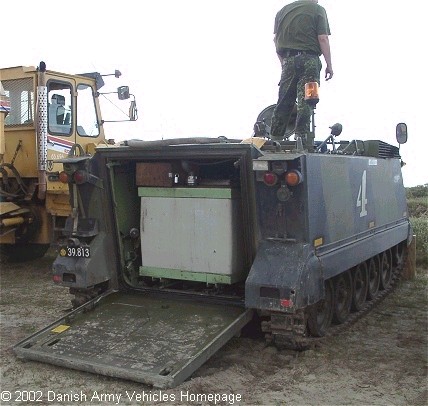
www.armyvehicles.dk/m113fire.htm
"The M113 Gavin fire fighting vehicle is used in training areas and shooting ranges. A 1, 500 liter water tank with heater is mounted at the rear. The pump is driven either by hydraulic or a petrol-engine. 2-man crew.
A dozer-equipped M-113 could cut a path for everyone else. Lends a whole new meaning to "fire suppression". Check out the internal tank. I'd rather have internal crew shelter and tow the water on a quick-detach pintle hitch remotely operated from the inside (a common 18-wheeler part).
The tragic loss of Crew 57 need not have happened if the Forest Service had appropriate vehicles.
(I don't work for any of the companies that make or retrofit these, by the way.)
The M113 Gavin armored personnel carrier is available as excess from the US government, and can be fitted with dozer blades as well as water pumps. They are light and can be carried by 18-wheelers on lowboy or Landoll trailers, and (if fitted with band tracks) driven at 45mph without asphalt damage.
Were Crew 57 so equipped (I'd recommend an external water trailer to preserve crew space) they could have jumped inside, closed the hatches, and DRIVEN out through the fire easily. How many firemen will die in place before we give them better choices?
Clearing a safe zone of combustibles, cutting firebreaks to rescue other crews, etc. is no problem. With simple tow cables the M113 can drag other vehicles to safety or out of the way as required. None of the technology is new, but for whatever reason only a few firefighting agencies think to acquire and use these assets.
'A nearby Forest Service crew watched as it happened, but could do nothing to save their colleagues.'
Neither crew could drive their wheeled trucks THROUGH flames or over burning material. APCs are designed to protect against napalm, among other nasties. They can drive over obstacles like burning vehicles.
Fire engines based on commercial truck chassis are not suitable for contact WITH fire. They burn, even their rubber tires are flammable, and their cabs are near their engine and fuel tanks. They are not equipped to protect and defend their own crews. Driving them next to a wildfire is like driving an unarmored truck in Iraq.
Why not use conventional dozers? Because they do not have crew protection or mount water cannon. The M113 is light (they have aluminum alloy armor hulls), can swim (try that with a fire engine), and is compact. Thousands are in service worldwide. Parts and maintenance are no problem.
If you have any more detailed questions regarding M113s, email the 1st TSG (A) at itsg@hotmail.com. He has far more M-113 info than I, and can get information to agencies interested in acquiring them.
Some links:
www.stormingmedia.us/37/3703/A370372.html
http://quanterion.com/RIAC/Library/Library.asp?ArgVal=161057
(I'm looking for a free version of the report elsewhere and will forward if I find it.)
Note the very simple water cannon and hose reel. These are ordinary commercial parts:
http://tanxheaven.com/mac/brandpmv/brandpmvm113ff.htm
http://www.uniteddefense.com/www.m113.com/ffv.html
www.roscommonequipmentcenter.com
The M548/M1015 has similarities to the more available M113.
http://www.roscommonequipmentcenter.com/fepp.html
The Forest Service and local fire departments can get these machines, and even if they only get a plain M113 they can get them outfitted by one of the many fire engine repair and refurb companies."
Defense Technical Information Center:
www.dtic.mil
Study download link:
http://handle.dtic.mil/100.2/ADA273073
Accession Number: ADA273073
Full Text (pdf) Availability:
Handle / proxy Url:
http://handle.dtic.mil/100.2/ADA273073
Citation Status: ACTIVE
Title: Armored Personnel Carrier (APC) Firefighting Vehicle System (M113a2 Firefighting System)
Fields and Groups :
131200 - SAFETY ENGINEERING
190300 - COMBAT VEHICLES
Corporate Author: APPLIED RESEARCH ASSOCIATES INC ALBUQUERQUE NM
Personal Author(s):
Wilson, M. J.
Storm, J. H.
Singh, G. B.
Risinger, Charles W.
Report Date: MAR 1992
Media Count: 69 Pages(s)
Organization Type: 4 - INDUSTRIAL/COMMERCIAL
Contract Number(s): F08635-88-C-0067 (F0863588C0067)
Report Number(s):
ESLTR-91-09 (ESLTR9109)
XCAFESC/ESL (XCAFESCESL)
DescriptiveNote: Final rept. 12-16 Feb 1991
Monitor Acronym(s):
ESL (ESL)
XC (XC)
Monitor Series:
TR-91-09 (TR9109)
AFESC/ESL (AFESCESL)
Descriptors:
*ARMORED PERSONNEL CARRIERS, *FIRE SUPPRESSION, TEST AND EVALUATION, WARFARE, WATER, RATES, TIME, FUELS, TRENCHES, SKIDS, EXTINGUISHING, FEET, SUPPRESSION, FIRE EXTINGUISHING AGENTS, DESERTS, INTERNAL, HYDROCARBONS, OPERATION, STORMS, CLAY, PERSONNEL
Identifiers:
M-113A2 VEHICLES.
Abstract:
This project evaluated the fire suppression capabilities of an M113A2 Armored Personnel Carrier (APC), modified with an internal skid-mounted 'fire suppression system. Six different agents were tested with the APC system to evaluate their fire extinguishing time, burnback rate, throw range, reservicing time, and ease of reservicing. To facilitate this test program, a 96 feet by 10 feet trench was constructed with a 15 inch high clay berm. JP-4 fuel (250-500 gallons) was floated on water in the trench and burned to simulate large hydrocarbon fires anticipated in combat operations during operation Desert Storm . The M113A2 APC system, using AFFF as the superior agent, was found to be effective in combating large tactical fires Hydrocarbon fuel fires, Fire extinguishing agents, AFFF, Pyrocap PVC, Phirex, Hurri-safe, Acu-lite.
Distribution Limitation(s):
01 - APPROVED FOR PUBLIC RELEASE
Source Serial: F
Source Code: 412136
Document Location: DTIC AND NTIS
Geopolitical Code: 3501
Distribution Statement:
Approved for public release; distribution is unlimited.
Citation Updated: 18 JAN 2006
http://news.bostonherald.com/national/view.bg?articleid=164283
4 firefighters killed in Calif. wildfire when flames overtake vehicle; 400 stranded at RV parkBy Associated Press
Thursday, October 26, 2006 - Updated: 06:31 PM ESTPOPPET FLAT, Calif. - A wind-whipped wildfire started by an arsonist killed four firefighters Thursday and stranded up to 400 people in an RV park when flames burned to the edge of the only road out, officials said.
"Everybody is hunkered down here. They're fighting the fire around us. It's across the street from us," said Charles Van Brunt, a ranger at the station at the entrance to Silent Valley Club, the recreational vehicle park near Palm Springs. The residents were in no immediate danger, he said.
Authorities asked people in the RV park to stay put to leave the roads clear for firefighters. Hundreds of others in the area were forced from their homes.
Fire officials said the fire was deliberately set around 1 a.m. and offered a $100,000 reward. Fire Chief John Hawkins said the arson "constitutes murder."
The Forest Service crew was trying to protect a house as dry desert winds of 25 mph or more blew a wall of flames down on them in the hills northwest of Palm Springs.
"They had left their truck to do structure protection when the fire overran them," said Forest Service spokesman Pat Boss, adding the flames came down so quickly they had no time to retreat to their engine or use protective sheltering.
Three firefighters died at the scene and two were hospitalized in critical condition. One of those two died several hours later. The other had burns over 95 percent of his body, Boss said.
The last time four firefighters died battling a blaze was July 10, 2001, fighting a fire in a remote canyon in Washington's Okanogan National Forest. The four became trapped by flames on a dusty dead-end road.
Thursday's deaths brought to 19 the number of California firefighters killed in the line of duty over the past year, according to statistics kept by California Professional Firefighters, a lobbying organization.
One other firefighter in the burned-out fire engine was critically injured, Boss said.
He said the Forest Service pulled all its personnel off the fire after the deaths so they could "gather their thoughts, say their prayers."
The fire quickly blackened more than six square miles and destroyed at least three homes. The weather service had issued a "red flag" warning for extreme fire danger because of the high winds and dry conditions.
Thick smoke blanketed the small RV park off Highway 243, where as many as 400 people were stranded, authorities said. TV footage showed some vehicles racing through flames and smoke just before firefighters closed the road.
Van Brunt said people were advised to "watch the news and stay comfy."
The cause of the wildfire was not immediately clear. It started early Thursday, burning in a valley with a few scattered ranch homes. The hamlets of Poppet Ranch and Twin Pines were evacuated along with a juvenile detention center, Twin Pines Boys Ranch.
Evacuations were ordered, and by early morning, about 200 people had left their homes, fire Capt. Julie Hutchinson said.
Officials worried the flames could reach an area of the San Bernardino National Forest where a bark beetle infestation had killed trees that could easily fuel a blaze.
In the valley where the fire was burning, the ground cover is mostly grass and chaparral that burns fast and hot.
"The biggest concern is if it gets over the hills," said Becky Luther, a spokeswoman for the Riverside County Fire Department. "That's where all of the homes are."
Timo Hargu, 61, said he rushed from his hilltop home with his two dogs after he looked out a window and saw fire burning toward him in a valley.
"The whole thing was ablaze with flame," he said. "It was the most spectacular view. A terrible view, but spectacular."